The OCZ Vector 180 (240GB, 480GB & 960GB) SSD Review
by Kristian Vättö on March 24, 2015 2:00 PM EST- Posted in
- Storage
- SSDs
- OCZ
- Barefoot 3
- Vector 180
AnandTech Storage Bench - The Destroyer
The Destroyer has been an essential part of our SSD test suite for nearly two years now. It was crafted to provide a benchmark for very IO intensive workloads, which is where you most often notice the difference between drives. It's not necessarily the most relevant test to an average user, but for anyone with a heavier IO workload The Destroyer should do a good job at characterizing performance.
| AnandTech Storage Bench - The Destroyer | ||||||||||||
| Workload | Description | Applications Used | ||||||||||
| Photo Sync/Editing | Import images, edit, export | Adobe Photoshop CS6, Adobe Lightroom 4, Dropbox | ||||||||||
| Gaming | Download/install games, play games | Steam, Deus Ex, Skyrim, Starcraft 2, BioShock Infinite | ||||||||||
| Virtualization | Run/manage VM, use general apps inside VM | VirtualBox | ||||||||||
| General Productivity | Browse the web, manage local email, copy files, encrypt/decrypt files, backup system, download content, virus/malware scan | Chrome, IE10, Outlook, Windows 8, AxCrypt, uTorrent, AdAware | ||||||||||
| Video Playback | Copy and watch movies | Windows 8 | ||||||||||
| Application Development | Compile projects, check out code, download code samples | Visual Studio 2012 | ||||||||||
The table above describes the workloads of The Destroyer in a bit more detail. Most of the workloads are run independently in the trace, but obviously there are various operations (such as backups) in the background.
| AnandTech Storage Bench - The Destroyer - Specs | ||||||||||||
| Reads | 38.83 million | |||||||||||
| Writes | 10.98 million | |||||||||||
| Total IO Operations | 49.8 million | |||||||||||
| Total GB Read | 1583.02 GB | |||||||||||
| Total GB Written | 875.62 GB | |||||||||||
| Average Queue Depth | ~5.5 | |||||||||||
| Focus | Worst case multitasking, IO consistency | |||||||||||
The name Destroyer comes from the sheer fact that the trace contains nearly 50 million IO operations. That's enough IO operations to effectively put the drive into steady-state and give an idea of the performance in worst case multitasking scenarios. About 67% of the IOs are sequential in nature with the rest ranging from pseudo-random to fully random.
| AnandTech Storage Bench - The Destroyer - IO Breakdown | |||||||||||
| IO Size | <4KB | 4KB | 8KB | 16KB | 32KB | 64KB | 128KB | ||||
| % of Total | 6.0% | 26.2% | 3.1% | 2.4% | 1.7% | 38.4% | 18.0% | ||||
I've included a breakdown of the IOs in the table above, which accounts for 95.8% of total IOs in the trace. The leftover IO sizes are relatively rare in between sizes that don't have a significant (>1%) share on their own. Over a half of the transfers are large IOs with one fourth being 4KB in size.
| AnandTech Storage Bench - The Destroyer - QD Breakdown | ||||||||||||
| Queue Depth | 1 | 2 | 3 | 4-5 | 6-10 | 11-20 | 21-32 | >32 | ||||
| % of Total | 50.0% | 21.9% | 4.1% | 5.7% | 8.8% | 6.0% | 2.1% | 1.4 | ||||
Despite the average queue depth of 5.5, a half of the IOs happen at queue depth of one and scenarios where the queue depths is higher than 10 are rather infrequent.
The two key metrics I'm reporting haven't changed and I'll continue to report both data rate and latency because the two have slightly different focuses. Data rate measures the speed of the data transfer, so it emphasizes large IOs that simply account for a much larger share when looking at the total amount of data. Latency, on the other hand, ignores the IO size, so all IOs are given the same weight in the calculation. Both metrics are useful, although in terms of system responsiveness I think the latency is more critical. As a result, I'm also reporting two new stats that provide us a very good insight to high latency IOs by reporting the share of >10ms and >100ms IOs as a percentage of the total.
I'm also reporting the total power consumed during the trace, which gives us good insight into the drive's power consumption under different workloads. It's better than average power consumption in the sense that it also takes performance into account because a faster completion time will result in less watt-hours consumed. Since the idle times of the trace have been truncated for faster playback, the number doesn't fully address the impact of idle power consumption, but nevertheless the metric is valuable when it comes active power consumption.
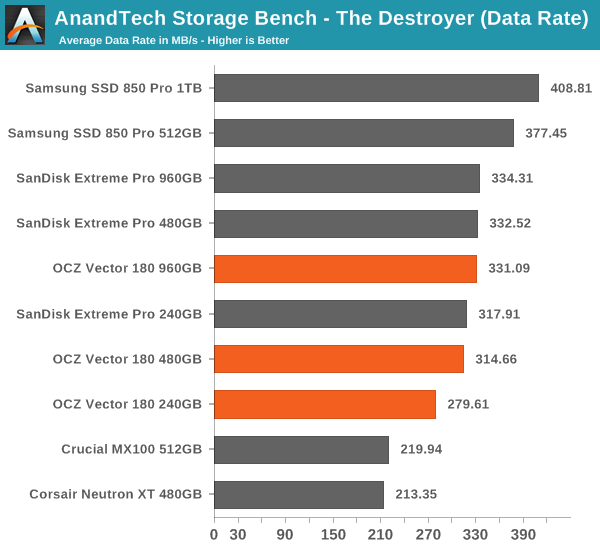
For a high-end drive, the Vector 180 has average data rate in our heaviest 'The Destroyer' trace. At 480GB and 960GB it's able to keep up with the Extreme Pro, but the 240GB model doesn't bear that well when compared to the competition.
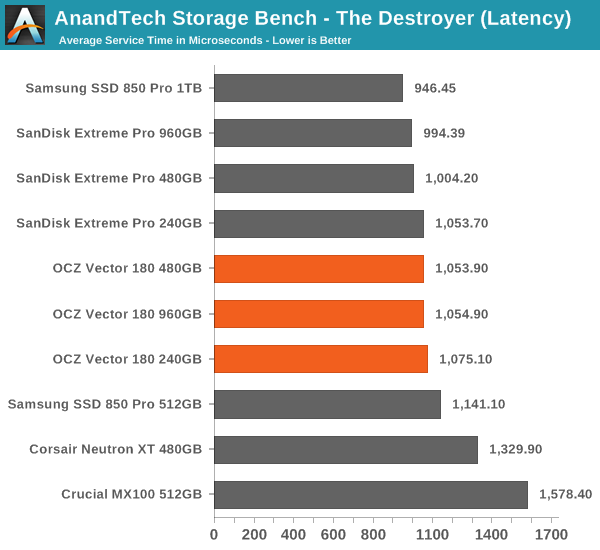
The same story continues when looking at average latency, although I have to say that the differences between drives are quite marginal. What's notable is how consistent the Vector 180 is regardless of the capacity.
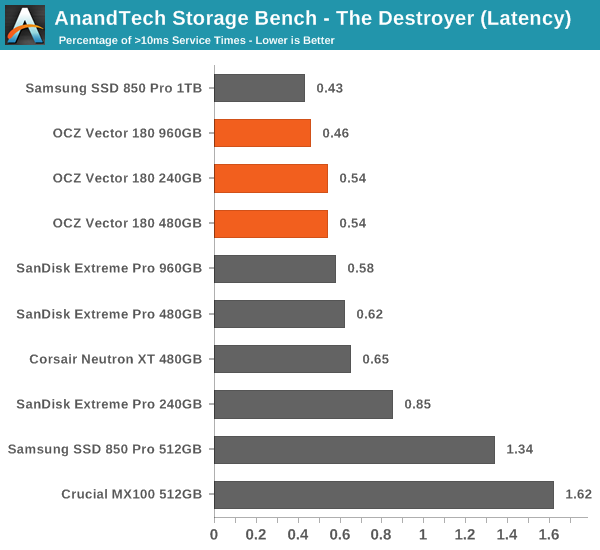
Positively, the Vector 180 has very few high latency IOs and actually leads the pack when looking at all capacities.
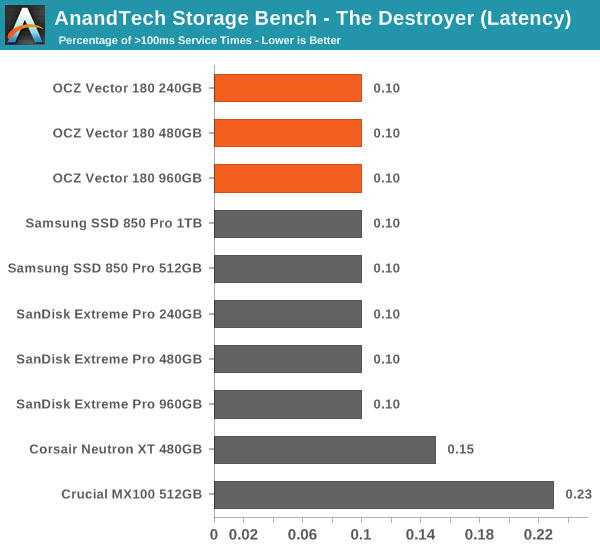
The Vector 180 also appears to be very power efficient under load and manages to beat every other SSD I've run through the test so far. Too bad there is no support for slumber power modes because the Barefoot 3 seems to excel otherwise when it comes to power.
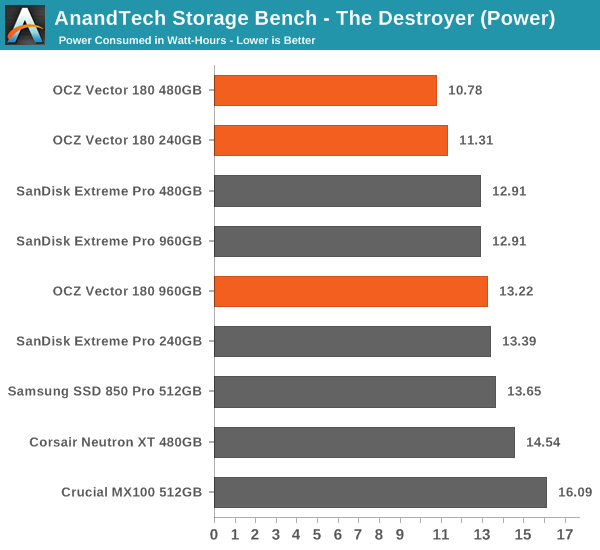










89 Comments
View All Comments
Guspaz - Tuesday, March 24, 2015 - link
Well, one person in particular had difficulty remembering the proper saying while in Tennessee...Minion4Hire - Tuesday, March 24, 2015 - link
He's quoting George Bush.mapesdhs - Wednesday, March 25, 2015 - link
And hence not exactly a viable rationale for concluding anything about anything.Ian.
CaedenV - Tuesday, March 24, 2015 - link
Cant beat the Evo on price, performance, or support... so then what is the point?kmmatney - Tuesday, March 24, 2015 - link
None of the benchmarks include the EVO, so it's hard to tell if it beats it or not. It is probably faster, but the MSRP is the same as the 850 Pro, which definitely beats it in most tests.ocztosh - Tuesday, March 24, 2015 - link
Hi CaedenV, thank you for your feedback. The Vector 180 is designed for the high performance/workstation market and is not positioned versus the TLC based EVO. When it comes to best balance of performance/value our ARC series (based on MLC). We will be coming out with future products that push the value envelope that leverage Toshiba TLC.mapesdhs - Wednesday, March 25, 2015 - link
I was impressed with the Arc 100, it was quicker than I expected. Any data yet on returnrates? It would be interesting to know if it's been competitive with the 850 EVO in that regard.
Samsung has a strong reputation here. My main concern with the Vector 180 though is it will
appear too expensive compared to the 850 Pro and SanDisk Extreme Pro.
Ian.
chrnochime - Tuesday, March 24, 2015 - link
The point is some ppl don't actually want to use TLC.ocztosh - Wednesday, March 25, 2015 - link
Hi chrnochime, thank you for your comments. We so agree there are still a lot of customers that would still prefer MLC. Our current value drive series is MLC based and even after we introduce a TLC based Series we will continue to deliver MLC drives for those customers that are looking for drives higher up the performance spectrum.chrnochime - Tuesday, March 24, 2015 - link
Support? So how long did that TLC fix take to be available again?